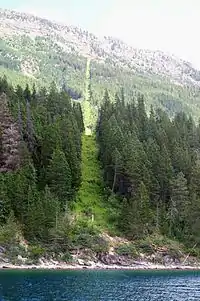Canada-United States international border vista
The Canada-United States international border vista is a man-made track of deforestation that demarcates portions of the border between the two nations.
Description

Colloquially known as "the Slash," this border vista is a 20-foot-wide (6.1 m) man-made cut-through of forestland maintained along areas of the border with dense forestation. There are many different sections of the vista, and the total length can vary depending on cycles of maintenance and upkeep, but an approximate length of 1,349 miles (2,171 km) has been reported by the United States Department of Homeland Security (DHS).[1]
From a bird's eye perspective, the vista appears as a "line" running through the wilderness, and can be clearly seen on satellite imagery. From the ground, one would observe that the vista follows a series of man-made monuments that were intended to mark the border along the northern 49th parallel, the Alaska/Canada border, and the non-linear eastern border; but due to inaccurate measurements made by surveyors in the 19th century, the vista strays from the exact coordinates by hundreds of feet in some places.[2] However the vista is accepted by both nations as the physical representation of the border when it comes to enforcement. It is illegal to cross the vista without official permission.[3]
History
The vista was the result of a larger border maintenance plan officially agreed upon by the two nations in treaties signed in 1908 and 1925 (the vista had existed, unofficially, since the 1800s).[4] The International Boundary Commission (IBC) was created by the treaties, comprised of members from both nations, and mandated to clearly demarcate the international border.[5] In more populous, less forested areas, this was accomplished largely with signs, momuments, physical barriers, and service roads; but the mountainous terrain and wilderness conditions in certain areas made that approach inpractical, thus the 20-foot-wide track of deforestation was adopted as a solution.[6]
Maintenance
Each country is responsible for funding the maintenance of 10 feet (3.0 m) on either side of the center-line. The IBC reports a $1.4 million annual budget (total amount for all border maintenance, including vista clearing), which equates to about one half cent per tax payer each year. Every six years the vista undergoes an extensive cut-back of any encroaching wilderness.[7][8][9]
Enforcement
The U.S. Customs and Border Protection agency (CBP) is tasked with monitoring all border activity, however this can be challenging in the remote areas of the vista. Thus, DHS and the CBP's divisions of border patrol cooperated to install third party technology in the form of solar powered, motion-detecting surveillance equipment, known as the Slash CameraPole (sic) system. The equipment is generally placed along areas of the vista that are within hiking distances of major highways.[10]
References
- Department of Homeland Security, Snapshot: Protecting our Northern Border with the Slash CameraPole
- CPG Grey, Canada & The United States (Bizarre Borders Part 2)
- Seven Days Vermont, Why is There a "Slash" in the Trees at the U.S.-Canada Border
- Guff.com, ""The Slash," which dates back to the 1800s, was set at the 49th parallel during an era where there was no GPS."
- International Boundary Commission official website, About us
- 99 Percent Invisible (article), The Slash: 20-Foot Clearing Stretches 5,525 Miles Across World's Longest Border
- IBC Joint Report, 2018, page 13, "Vista clearing work was due for this section as part of its six-year vegetation management cycle."
- Atlas Obscura, United States-Canada Border Slash
- Guff.com, Every Year American Taxpayers Pay to Deforest Every Inch of the US-Canada Border
- Department of Homeland Security, Snapshot: Protecting our Northern Border with the Slash CameraPole